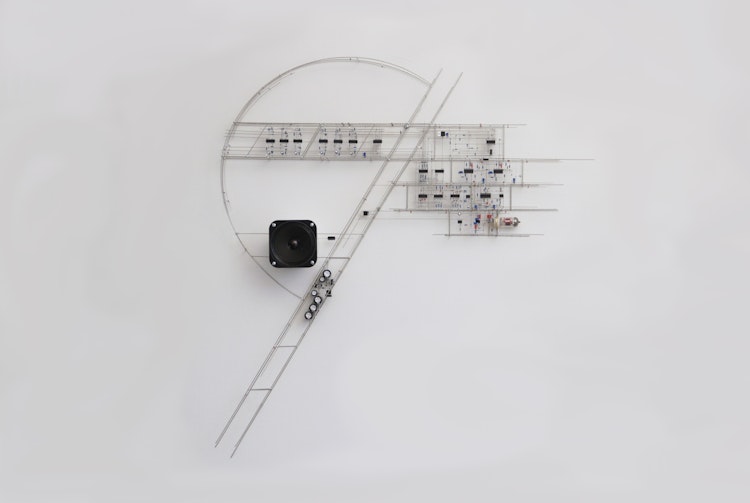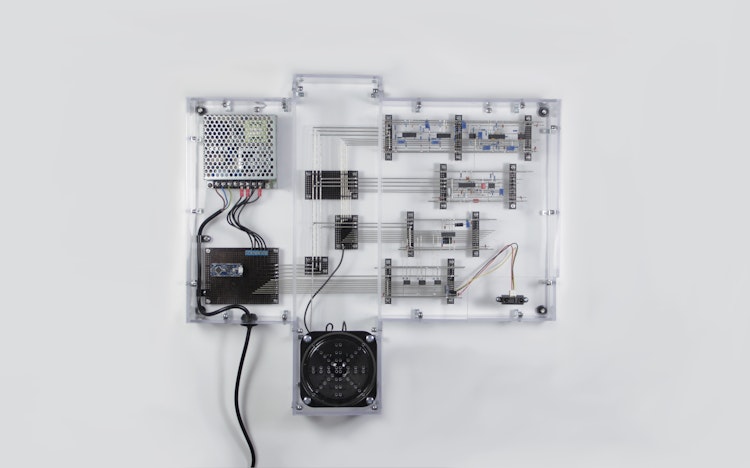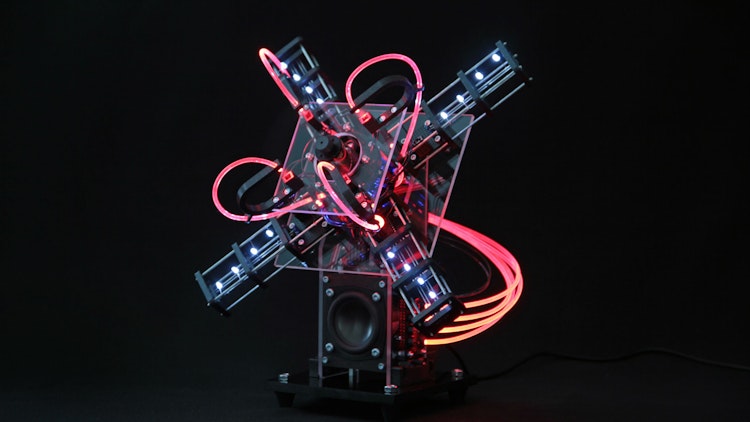We would like to play you a sound piece while you read. Is this OK?
Eirik Brandal - Myrhøne (2021). Electronic sound and media sculpture. Video by Eirik Brandal.
Eirik Brandal - ddrysfeöd (2021). Electronic sound and light sculpture. Video by Eirik Brandal.
Eirik Brandal - corwin point (2022). Electronic sound and light sculpture. Video by Eirik Brandal.
Eirik Brandal is an artist and composer, while originally studying music composition, his work has shifted toward electronic sound sculptures, looking to uncover the intrinsic beauty of circuits. In this text, Brandal writes about the construction and composition strategies of his electronic sculptures. He reflects on craft in relation to his own artistic background in music composition and sonology, and contemplates on how artists are necessarily shaped by the tools they are working with.
This article first and foremost revolves around the construction and composition strategies of electronic sound sculptures. While I realise there is a certain gap between electronic sound sculptures and, in the most traditional interpretation of the word, crafts – there are also similarities and overlaps in execution, at least on a surface level.
With my background and formal education in music composition and sonology 1 – both in this day and age firmly rooted in the digital realm – the transition to a more physical approach has been gradual and difficult. I’ve always regarded computer work, be it for design or editing music, as a form of sculpting in the sense that it’s a linear process; you engage with the material directly, and the final render is the actual end result. As a composer, I was discomfited by the fact that what I regarded as the finished work – the score – had to be interpreted by instrumentalists in order to be performed. I think this non-linearity prompted me to change my approach both to music and my own artistic practice, adopting workflows more closely aligned with the desired artistic outcome at a detail level.

While preparing for this article, I had the pleasure of speaking to one of the editors of this issue of this magazine, Stian Korntved Ruud. We stumbled upon the topic of how we as artists are shaped by the tools we are working with, and it made me realise that it’s a significant common thread in my sculptural work – consider for instance the difference between my 2019 work waldian, and 2023’s cythemic rotary transmission. In the case of the former, the only tool at my disposal was a soldering iron, undeniably leading to a focus on techniques and materials associated with soldering. I currently have access to a larger arsenal of tools, allowing for a greater selection of shapes and materials, which is reflected in my more recent works. The pitfall of an abundance of choice is the loss of discipline enforced by strict rules – rules that are formed by simply not having an alternative. With strict rules come a cleaner output based on a clear framework. One such framework could, for instance, be to only use straight lines, enforced by the available tools, for example a table saw – or, due to demands cradled in the laws of electronics, have separate structures for each signal and power rail, which can lead to interesting and challenging designs in terms of signal logistics.
Eirik Brandal, cythemic rotary transmission demo (2023) electronic sound sculpture. Video: All rights belongs to the artist.
One particular aspect of electronics I embrace is its modularity; similar to an ecosystem, electronics have parts that are dependent on each other, and this can be brutally exploited to an artist’s advantage.
Working with electronics does have multiple advantages due to its multifaceted nature. I like to compare it to archaeology, because a circuit’s design is inherent to its function, and its functional requirements have physical demands. One could argue that a finite amount of design possibilities already exists, and you have to “excavate” the most suitable alternative. Likewise, it is also easy to draw parallels with functionalist architecture, where “form follows function” is a unifying thread. Strictly speaking, this of course only applies to pure electronic works, where the electronic components constitute the entire design; from signal paths to mechanical support. As briefly touched upon earlier in the article, once you introduce other materials and techniques, these guidelines become somewhat diluted.
One particular aspect of electronics I embrace is its modularity; similar to an ecosystem, electronics have parts that are dependent on each other, and this can be brutally exploited to an artist’s advantage. You can, for instance – speaking in terms of sound – entirely skip the compositional process (such as an algorithmic composition or a fixed linear piece) and instead rely on strategies of sonification and visualisation of the inner workings of the electronic ecosystem. Sonification in itself is an interesting beast, and it is conventionally used as a means to translate a system’s process into something humans can understand, such as an alarm on a control panel.2 In the context of art, translating raw data into acoustic signals can be exciting and lead to unpredictable results, but it can also end up far beyond the range of what anyone – musician, engineer, or audience alike – can endure for a prolonged period of time. But all in all, it can provide a deeper insight into how a system functions, and from an educational standpoint, it serves as a valuable analytical tool for comprehending how electronic signal paths are interconnected.

This transparency between machine and audience could be further enhanced by adding means of interaction through sensors. In this context, the sculpture doesn't need to transform into a traditional instrument; instead, the sensors can serve as a means to facilitate dialogue. Participating parties in this dialogue don’t necessarily have to be of human origin, either. The electronic ecosystem discussed earlier could be expanded on, with multiple sculptures communicating using OSC (Open Sound Control) 3 – a protocol frequently used to interconnect audiovisual systems on a network – each playing a vital role in the larger ecosystem. While interaction of this kind constitutes a valid compositional strategy – and could perhaps be appropriately labeled as “performative” – there is also another dimension to it in the form of “peculiar machine conduct”, where certain quirks of the apparatus are enhanced.
Besides an undisclosed project I’m working on right now, where literal motion within the sculpture is hyper-amplified, faults or unintended behaviour can be incorporated as an “improvisational” layer, for example sounds you have little to no semblance of control over. These external (or internal) influences can be either embraced or removed, depending on their auditory quality. I would, however, readily exclude interference caused by inadequate grounding as an improvisational element. It always rears its ugly head if you leave the door open.
